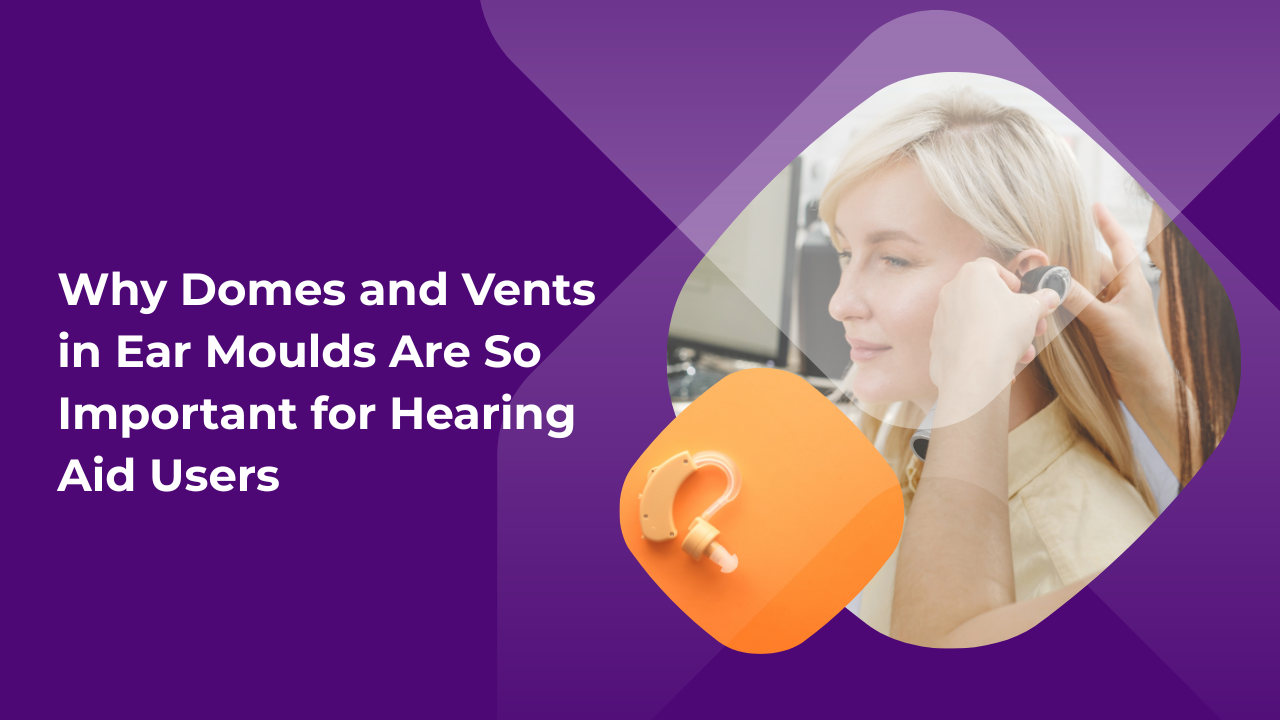When people choose a hearing aid, they usually focus on the model, battery, or tech features. Few realize that a poor dome and vent fit can cause discomfort, poor sound, and even increase the chance of ear infections. The dome and vent are two small but essential parts that sit right inside your ear where the real hearing experience begins.
Even if you have the most advanced hearing aid , if the dome doesn’t fit well or the vent is wrong for your hearing type, your experience will be frustrating. You’ll hear echoes, feel pressure, or face unwanted feedback noises. This article breaks down how each part works, why it matters, and what to look for when choosing.
What Are Domes and Vents in Hearing Aids?
Domes and vents work together to deliver a clear and balanced hearing experience. Here’s what they do:
- Domes are soft silicone tips that attach to the hearing aid’s receiver and sit inside your ear canal.
- Vents are small holes (either in the dome or mould) that allow airflow and natural sound to enter the ear canal.
How Domes Influence Sound and Comfort
1. Fit and Size Matter
Domes come in different sizes and types — open, closed, and power domes. The goal is to find one that seals your ear comfortably without applying pressure.
- Open Domes: Ideal for mild hearing loss. They allow natural sound to mix with amplified sound, making speech feel more real.
- Closed Domes: Block more external sound and are better for moderate hearing loss.
- Power Domes: Tighter seal, stronger amplification. Suited for severe hearing loss.
Example: If a user has trouble hearing conversations in noisy places, a power dome helps concentrate the sound. But if they feel pressure or blocked, switching to a closed dome with a small vent could help.
2. Sound Quality
The dome controls how much sound enters your ear. A poor fit leads to feedback (whistling noise), distortion, or even hearing fatigue. A good fit directs the amplified sound cleanly to your eardrum.
3. Customization for Unique Ear Shapes
Everyone’s ear canal is different. The dome must sit securely, without shifting, to avoid sound leaks. That’s why audiologists often try multiple options during fittings.
What Role Vents Play in the Listening Experience
1. Comfort Throughout the Day
Vents prevent that “blocked” sensation, often called the occlusion effect. Without vents, many users feel like they’re talking in a tunnel.
2. Natural Sound Blending
A vent allows ambient sound (like your own voice or soft background noise) to enter naturally. This avoids the robotic sound that can happen with closed systems.
3. Moisture Control and Hygiene
Vents improve airflow inside the ear. This reduces sweat build-up and lowers the risk of ear infections. Especially important in hot or humid weather.
4. Pressure Balance
With no vent, pressure can build inside the ear canal, leading to discomfort. Even a small vent can release this pressure and make the device wearable for longer hours.
Want to understand more about occlusion and vents? Visit the American Speech-Language-Hearing Association.
Choosing the Right Dome and Vent: Step-by-Step Guidance
Step 1: Get a Hearing Test
Work with a certified audiologist to assess your hearing range. Dome and vent choices depend on your hearing profile.
Step 2: Start with Manufacturer Recommendations
Hearing aid manufacturers suggest dome types based on the device and hearing level. This gives a useful baseline.
Step 3: Try Multiple Dome Types
Don’t settle on the first one. A quick test of different dome styles in the clinic helps find the most comfortable and effective option.
Step 4: Pay Attention to Feedback and Blockage
If you hear whistling or feel blocked, let your provider know. Small changes in dome size or vent placement can resolve big issues.
Step 5: Re-check Over Time
Your ears may change shape slightly, or your hearing needs might shift. Review dome and vent fit every 6–12 months.
Key Takeaways
→ Domes and vents are critical for comfort, sound clarity, and ear health.
→ Open domes are better for mild loss, power domes for severe loss.
→ Vents reduce pressure, improve airflow, and allow more natural sound.
→ A poor dome fit causes feedback, echo, and user frustration.
→ Regular checks with an audiologist improve long-term comfort.
→ Small parts like these make a big difference in everyday hearing.
How Crystal Hearing Solutions Helps You Find the Right Fit
At Crystal Hearing Solutions, our expert audiologists don’t just hand you a hearing aid—we guide you through choosing the dome and vent that work best for your ears. Every fitting is tailored, and we make sure you walk out with a setup that sounds good and feels natural.
Need help with your current device or want a better fit? Contact us today to book a consultation.
FAQ
1. How do I know if my dome fits correctly?
It should sit snugly without causing pain or pressure. If it falls out easily or creates a whistling sound, the fit likely needs adjustment.
2. Can I change domes and vents myself?
Most domes can be replaced at home with the right instructions. However, changing the vent often needs professional help, especially with custom moulds.
3. Do vents affect how much I hear?
Yes. A bigger vent allows more natural sound but may reduce low-frequency amplification. The right size balances clarity with comfort.
4. How often should domes be replaced?
Every 2 to 3 months, or sooner if damaged. Regular cleaning helps them last longer.
5. Can I use closed domes with mild hearing loss?
You can, but it may feel too blocked. Open domes usually offer a better experience for mild cases unless specific amplification is needed.
6. Why does my hearing aid whistle sometimes?
That’s feedback, often caused by a poor dome fit or blockage in the ear. Re-seating the dome or choosing the right size usually fixes the issue.
Conclusion:
The importance of domes and vents in hearing aid moulds can’t be overstated. While these components may seem minor, they play a major role in how users perceive sound, how comfortable the device feels, and how consistently it performs. An improper dome or inadequate vent can lead to avoidable issues like ear pressure, poor sound clarity, or even health problems. That’s why working with a qualified audiologist like those at Crystal Hearing Solutions makes all the difference. Their role isn’t just to provide a device, but to ensure every detail of your hearing solution is fine-tuned to fit your life. Whether you’re new to hearing aids or reevaluating your current setup, focusing on these details can significantly improve your daily listening experience.





